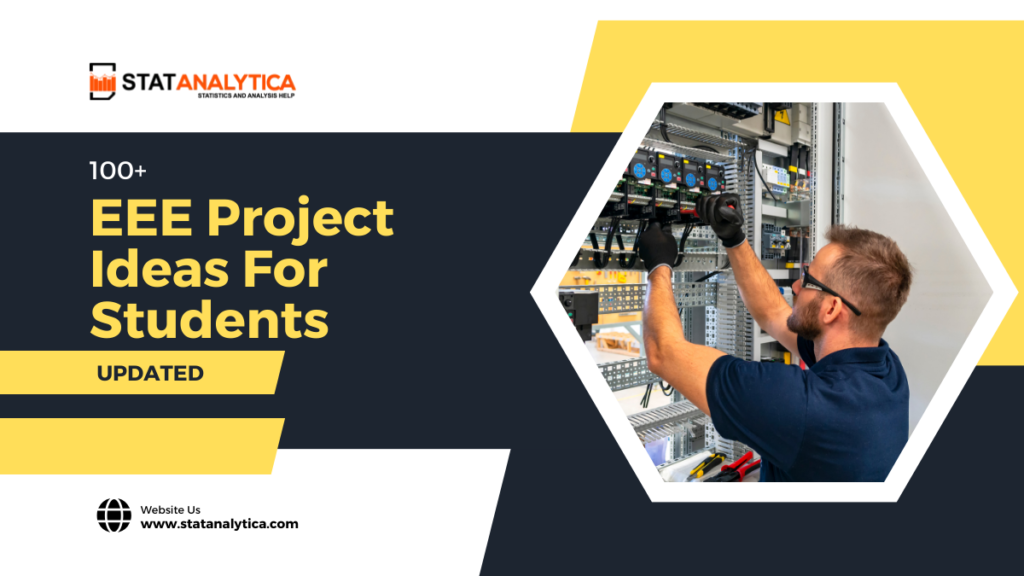In the realm of Electrical and Electronic Engineering (EEE), projects serve as the cornerstone for innovation and learning. Whether you’re a budding engineer or a seasoned professional, embarking on a project journey can be both exhilarating and rewarding. Today, we delve into a myriad of electrifying EEE project ideas that can ignite your creativity and propel you towards new horizons.

How To Do An Electrical Project?
Table of Contents
Doing an electrical project involves several key steps to ensure success:
- Identify Your Interest: Choose a topic within the broad field of electrical engineering that interests you. Whether it’s renewable energy, electronics, power systems, control systems, or communication, select a project that excites you.
- Research: Conduct thorough research on your chosen topic to understand its background, existing solutions, and potential areas for innovation. Utilize academic journals, textbooks, online resources, and professional publications to gather relevant information.
- Define Objectives: Clearly define the objectives and scope of your project. Determine what you aim to achieve, whether it’s designing a new system, improving an existing one, conducting experiments, or analyzing data.
- Plan: Develop a detailed project plan outlining the tasks, timeline, budget, and resources required. Break down the project into manageable stages and set achievable milestones to track progress effectively.
- Gather Resources: Gather the necessary resources, including components, equipment, software tools, and documentation. Ensure you have access to the required facilities, such as laboratories, workshops, and testing environments.
- Design: Based on your research and objectives, design the system, circuit, or software architecture for your project. Use engineering principles, simulation tools, and prototyping techniques to refine your design before implementation.
- Implementation: Build the project according to your design specifications. Assemble components, write code, fabricate circuits, or construct prototypes as needed. Pay attention to detail and ensure proper documentation throughout the implementation process.
- Testing and Evaluation: Test the functionality, performance, and reliability of your project through rigorous testing and evaluation. Conduct experiments, simulations, and real-world trials to validate your design and identify any issues or areas for improvement.
- Iterate and Improve: Based on the test results and feedback, iterate on your design to address any shortcomings or optimize performance. Continuously refine your project through iterations, incorporating lessons learned and innovative solutions.
- Documentation: Document your project thoroughly, including design specifications, test procedures, results, and conclusions. Create reports, presentations, or technical papers to communicate your findings and share your knowledge with others.
- Presentation and Dissemination: Present your project to peers, mentors, and stakeholders through presentations, demonstrations, or competitions. Share your experience, insights, and achievements with the wider community through conferences, workshops, or online platforms.
- Reflection and Learning: Reflect on your project experience, acknowledging successes and challenges encountered along the way. Identify opportunities for further learning and growth, whether it’s exploring new technologies, collaborating with others, or pursuing advanced studies.
By following these steps and maintaining a systematic approach, you can successfully execute an electrical project and contribute to the advancement of the field. Remember to stay curious, innovative, and persistent throughout your project journey, and enjoy the satisfaction of bringing your ideas to life.
100+ EEE Project Ideas For Students: Category Wise
Renewable Energy Projects
- Solar-powered street lighting system with automatic dusk to dawn operation.
- Wind turbine generator with MPPT (Maximum Power Point Tracking) control.
- Solar water heating system with temperature control and monitoring.
- Biogas plant automation for domestic or agricultural use.
- Portable solar charger for mobile devices with battery management.
- Hydroelectric power generation model using a miniature turbine.
- Dual-axis solar tracker for maximizing solar panel efficiency.
- Design and optimization of a biomass gasification system for electricity generation.
- Rainwater harvesting and storage system with automated irrigation control.
- Solar-powered desalination plant for freshwater production in coastal areas.
Electronics Projects
- Smart home automation system using IoT (Internet of Things) technology.
- Digital thermometer with LCD display and temperature logging.
- Wireless power transfer system for charging electronic devices.
- Gesture-controlled robot using accelerometer and microcontroller.
- RFID-based attendance system for schools or workplaces.
- Electronic voting machine with security features and result display.
- Arduino-based weather station for monitoring temperature, humidity, and rainfall.
- Bluetooth-controlled home appliances using a smartphone application.
- Voice-controlled home automation system using speech recognition.
- Digital clock with alarm and temperature display.
Power Systems Projects
- Design and simulation of a microgrid system with renewable energy sources.
- Fault detection and protection scheme for distribution networks.
- Load shedding and demand response system for peak load management.
- Power factor correction using capacitor banks for industrial applications.
- Real-time monitoring and control of electrical substations using SCADA.
- Grid-tied solar PV system with battery storage for residential use.
- Simulation of FACTS (Flexible AC Transmission Systems) devices for voltage control.
- Protection coordination study for distribution feeders.
- Design and optimization of a solar-powered water pumping system.
- Voltage stability analysis of power systems using MATLAB/Simulink.
Control Systems Projects
- PID controller design and tuning for temperature control of an oven.
- A line-following robot uses infrared sensors and PID control.
- Inverted pendulum stabilization using a feedback control system.
- PLC-based traffic light control system with pedestrian crossing.
- Automatic door opening and closing system using PIR sensors.
- Speed control of DC motor using PWM (Pulse Width Modulation).
- Temperature-controlled fan speed regulation using a microcontroller.
- Position control of a servo motor using PID algorithm.
- Water level control system for overhead tanks using sensors and actuators.
- Autonomous car navigation using GPS and obstacle detection sensors.
Communication Systems Projects
- Designed and implemented a digital communication system using MATLAB.
- GSM-based home security system with SMS alerts.
- Wireless sensor network for environmental monitoring.
- Satellite communication link analysis using satellite toolkit software.
- Design and simulation of a radar system for target detection.
- Digital audio transmission using FM modulation and demodulation.
- Zigbee-based wireless data acquisition system for industrial applications.
- Vehicle tracking and fleet management system using GPS and GSM.
- Optical fiber communication link design and performance analysis.
- Software-defined radio (SDR) receiver design and implementation.
Robotics Projects
- Robotic arm control using inverse kinematics and servo motors.
- Autonomous surveillance drone with obstacle avoidance capabilities.
- Line-following robot competition using IR sensors and microcontrollers.
- Humanoid robot design and implementation with speech recognition.
- Swarm robotics project with multiple coordinated robots.
- Firefighting robot with temperature and smoke sensors.
- Gesture-controlled robotic hand using flex sensors and Arduino.
- Telepresence robot for remote communication and control.
- Maze-solving robot using algorithms like Dijkstra’s or A*.
- Robotic wheelchair with obstacle detection and navigation.
Signal Processing Projects
- Speech recognition system using MFCC (Mel Frequency Cepstral Coefficients).
- Image processing application for facial recognition using OpenCV.
- ECG (Electrocardiogram) signal analysis for heart rate monitoring.
- Audio equalizer design and implementation using digital filters.
- EEG (Electroencephalogram) signal processing for brain-computer interface.
- Image compression using techniques like JPEG or PNG.
- Real-time audio processing for noise cancellation or echo suppression.
- Digital watermarking for copyright protection of multimedia content.
- Video stabilization algorithm for shaky camera footage.
- Adaptive noise cancellation using LMS (Least Mean Squares) algorithm.
Embedded Systems Projects
- The home energy monitoring and management system uses Raspberry Pi.
- Real-time GPS tracking system for vehicle fleet management.
- IoT-based smart agriculture system for crop monitoring and irrigation.
- Automated plant watering system with soil moisture sensors.
- RFID-based access control system for secure entry points.
- Real-time data logging and monitoring using Arduino and sensors.
- Wireless data acquisition system for remote industrial monitoring.
- Smart helmet for bikers with accident detection and SOS alert.
- Vehicle speed control system using RFID and GSM technology.
- Home security system with intruder detection and alarm.
Renewable Energy Integration Projects
- Grid-connected solar PV system with battery storage and islanding protection.
- Wind-solar hybrid power generation system for remote areas.
- Microgrid optimization using optimization algorithms like GA or PSO.
- Energy management system for residential or commercial buildings.
- Grid integration of small-scale hydroelectric power generation.
- Distributed energy resource management system (DERMS) for smart grids.
- Demand-side management strategies for peak load reduction.
- Grid stability enhancement using energy storage systems.
- Virtual power plant (VPP) implementation for aggregated energy resources.
- Cyber-physical energy systems for efficient energy utilization and control.
Industrial Automation Projects
- PLC-based conveyor belt control system for material handling.
- SCADA-based industrial process monitoring and control.
- Automated warehouse management system with RFID tracking.
- Pneumatic or hydraulic control system for industrial automation.
- Programmable logic controller (PLC) programming for manufacturing processes.
- HMI (Human-Machine Interface) is designed for operator control and visualization.
- Predictive maintenance system for machinery health monitoring.
- Automated packaging system with pick-and-place robots.
- Quality control system using machine vision for defect detection.
- Remote monitoring and control of industrial equipment using IoT.
Power Electronics Projects
- Buck-boost converter design and implementation for DC-DC conversion.
- Three-phase inverter design for grid-tied solar PV systems.
- MPPT algorithm implementation for maximum power extraction from solar panels.
- Motor drive control using PWM techniques for speed regulation.
- Power factor correction
(PFC) circuit design for industrial loads.
Factors to Consider When Choosing a Project Idea
- Personal interest and passion: Selecting a project aligned with your interests and aspirations ensures motivation and engagement throughout the project journey.
- Feasibility and resources required: Assessing the technical complexity and resource requirements of a project helps in planning and execution.
- Relevance to current industry trends: Choosing a project idea that addresses emerging challenges or trends in the EEE industry enhances its relevance and impact.
- Potential impact and innovation: Seeking projects with the potential to make a meaningful contribution to society or advance the state-of-the-art in EEE fosters creativity and innovation.
- Educational and learning opportunities: Opting for projects that offer opportunities for learning new skills, gaining practical experience, and collaborating with peers enriches the project experience and personal growth.
Conclusion
Embarking on an EEE project journey is an exhilarating endeavor that offers boundless opportunities for learning, innovation, and personal growth. Whether you’re passionate about renewable energy, electronics, power systems, control systems, or communication systems, there’s a myriad of exciting project ideas waiting to be explored.
By choosing the right EEE project ideas aligned with your interests, leveraging available resources, and embracing the spirit of creativity and innovation, you can energize your passion for EEE and make a meaningful impact in the world of engineering and technology.
So, roll up your sleeves, ignite your imagination, and embark on a journey of discovery and innovation in the fascinating realm of Electrical and Electronic Engineering. The future awaits, and the possibilities are endless.


